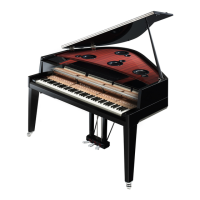
Do you have a question about the Yamaha AvantGrand N3X and is the answer not in the manual?
| Type | Hybrid Piano |
|---|---|
| Polyphony | 256 notes |
| Headphone Jacks | 2 |
| USB Audio Interface | Yes |
| Bluetooth | No |
| USB to Host | Yes |
| USB to Device | Yes |
| Display | LCD |
| Finish | Polished Ebony |
| Pedals | 3 (Damper, Sostenuto, Soft) |
| Sound Source | Yamaha CFX, Bösendorfer Imperial |
| Effects | Reverb, Brilliance |
| MIDI | In/Out |
Verify local AC mains voltage matches the instrument's rating for safe operation.
Explains hazard symbols and safety warnings found on the product.
Information on battery handling, product disposal, and environmental considerations.
Location of the name plate for recording model and serial numbers.
Details on FCC regulations, modifications, and compliance statements for US users.
Detailed explanation of hazard and warning symbols used throughout the manual.
A list of essential safety instructions for proper operation and maintenance.
Warnings related to power supply, water exposure, fire risks, and abnormal instrument conditions.
Precautions for assembly, placement, and avoiding physical injury during use.
Cautions for handling the instrument, using the bench, and environmental considerations.
Guidelines for cleaning, care, and saving instrument data to external storage.
Information on copyrights, manual usage, and bundled data features.
Details on pitch adjustment and safe methods for moving the instrument.
Describes the grand piano action, keyboard construction, and sensor technology.
Details on acoustic sampling, speaker placement, and headphone sound technologies.
Identifies all jacks and terminals on the instrument with references for detailed information.
Explains the function of each control panel button and the instrument's display.
Instructions for opening and closing the keyboard fallboard safely.
How to raise, lower, and secure the music rest and its brace.
Safe procedures for opening and closing the instrument's lid and lid stay.
Instructions for connecting the power cord and setting the correct voltage selector.
Step-by-step guide for powering the instrument on and off.
Explains the auto power off feature and how to disable or enable it.
How to adjust master volume and use the Intelligent Acoustic Control (IAC) feature.
How to connect headphones and activate Binaural Sampling/Stereophonic Optimizer.
Explains the function of the Damper, Sostenuto, and Soft pedals.
Guide to selecting different piano voices and understanding their characteristics.
How to play demo songs to audition instrument voices and adjust tempo.
How to start, stop, select beats, and adjust the metronome volume.
How to adjust the tempo for Metronome, MIDI Songs, and Audio Songs.
How to customize how the sound responds to playing touch velocity.
How to turn TRS on/off and adjust the vibration intensity for realism.
How to enable VRM and adjust damper/string resonance depth for realism.
How to apply and adjust reverb effects and sound brightness (tone color).
How to transpose the entire keyboard pitch up or down in semitones.
How to fine-tune the instrument's pitch for ensemble playing or recording.
How to select different scales and specify base notes for tuning.
Information on MIDI and Audio song formats and instrument compatibility.
How to select song categories, numbers, and start playback.
Adjusting audio song volume, song navigation, and character code settings for playback.
Explains MIDI and Audio recording, connecting USB drives, and selecting recording methods.
Steps for starting, stopping, saving, and managing recorded MIDI or Audio songs.
Guidelines for connecting, using, protecting data, and formatting USB flash drives.
Step-by-step instructions for formatting a USB flash drive for instrument use.
How to copy User Songs from the instrument's internal memory to a USB flash drive.
How to delete song files and understand the correct file structure for USB playback.
Information on data retained after power off and how to initialize backup data.
How to connect audio players via AUX IN and manage input noise with the Noise Gate.
How to connect to external stereo systems and mixers using AUX OUT and OUTPUT jacks.
How to connect to computers and smart devices via USB and MIDI.
How to connect external MIDI devices and transfer performance and setting data.
How to enable or disable local control for keyboard output to MIDI instruments.
Explains various on-screen messages displayed by the instrument for troubleshooting.
Provides solutions for common issues encountered when operating the instrument.
A list of all preset songs included with the instrument and their composers.
Lists all parts and outlines the initial steps for assembling the instrument.
Instructions for attaching the legs, pedal brace rods, and the pedal unit.
Instructions for connecting the pedal cord, power cord, and performing final assembly checks.
A comprehensive list of the instrument's technical specifications, dimensions, and features.
Quick reference for setting various instrument parameters using button and key combinations.
